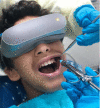Effect of virtual reality distraction on pain and anxiety during infiltration anesthesia in pediatric patients: a randomized clinical trial
- PMID: 34172032
- PMCID: PMC8234622
- DOI: 10.1186/s12903-021-01678-x
Effect of virtual reality distraction on pain and anxiety during infiltration anesthesia in pediatric patients: a randomized clinical trial
Abstract
Background: Different distraction techniques have been used in dentistry and have shown great results in managing anxious pediatric patients specially during local anesthesia administration. One of the recently invented techniques is virtual reality. The purpose of the study was to evaluate the effect of virtual reality distraction on anxiety and pain during buccal infiltration anesthesia in pediatric patients.
Methods: Healthy, cooperative 6- to 12-year-old children requiring buccal infiltration anesthesia were randomly assigned to a test or control group. In the test group, local anesthesia was administered while the subjects were watching a cartoon video using virtual reality goggles. Subjects in the control group watched a cartoon video on a screen during the administration of local anesthesia. To assess anxiety in both groups, heart rate was recorded using a pulse oximeter at five time points: (1) once the subject sets on the dental chair as a baseline; (2) when video is on; (3) at topical anesthesia application; (4) during needle insertion; (5) after the administration of local anesthesia. The face, legs, activity, cry, consolability (FLACC) behavioral pain assessment scale and the Wong-Baker FACES pain rating scale were used to assess pain.
Results: A total of 50 subjects were included with a mean age of 8.4 ± 1.46 years. Twenty-nine (58.0%) of the subjects were females. The mean heart rate at all time points except baseline was significantly higher among the test group compared to the control group. Multiple regression analysis showed that younger subjects and females had higher mean FLACC behavioral pain assessment scale scores (P = 0.034 and P = 0.004, respectively) regardless of the distraction technique used. Younger subjects and subjects with higher baseline heart rate reported higher mean Wong-Baker FACES pain rating scale score (P = 0.031 and P = 0.010, respectively), controlling for all other variables.
Conclusion: Female subjects and the younger age group were more likely to report higher pain scores during local anesthesia administration regardless of the type of distraction used.
Trial registration: The study was retrospectively registered in ClinicalTrials.gov with the identifier: NCT04483336 on 23/07/2020.
Keywords: Anxiety; Distraction; Infiltration anesthesia; Pain; Virtual reality.
Conflict of interest statement
The authors have no conflicts of interest to declare.
Figures



Similar articles
-
The effect of DentalVibe on pain and discomfort during local anesthesia in children: a randomized clinical trial.Quintessence Int. 2021;52(5):434-443. doi: 10.3290/j.qi.b912695. Quintessence Int. 2021. PMID: 33491390 Clinical Trial.
-
Comparison between the analgesic effectiveness and patients' preference for virtual reality vs. topical anesthesia gel during the administration of local anesthesia in adult dental patients: a randomized clinical study.Sci Rep. 2021 Dec 8;11(1):23608. doi: 10.1038/s41598-021-03093-2. Sci Rep. 2021. PMID: 34880344 Free PMC article. Clinical Trial.
-
Effect of immersive virtual reality on pain in different dental procedures in children: A pilot study.Int J Paediatr Dent. 2022 Mar;32(2):264-272. doi: 10.1111/ipd.12851. Epub 2021 Jul 5. Int J Paediatr Dent. 2022. PMID: 34133809 Clinical Trial.
-
Effectiveness of Virtual Reality Glasses as a Distraction for Children During Dental Care.Pediatr Dent. 2020 Mar 15;42(2):93-102. Pediatr Dent. 2020. PMID: 32276674 Review.
-
[The potentials of virtual reality in pediatric perioperative care].Orv Hetil. 2025 Jan 12;166(2):50-59. doi: 10.1556/650.2025.33183. Print 2025 Jan 12. Orv Hetil. 2025. PMID: 39799546 Review. Hungarian.
Cited by
-
A Brief Review on Engaging and Interactive Learning for Children: Exploring the Potential of Metaverse-Based Oral Health Promotion.Int J Dent. 2024 Feb 12;2024:6679356. doi: 10.1155/2024/6679356. eCollection 2024. Int J Dent. 2024. PMID: 38375435 Free PMC article. Review.
-
Virtual reality vs. Tablet video for venipuncture education in children: A randomized clinical trial.PLoS One. 2024 Aug 27;19(8):e0307488. doi: 10.1371/journal.pone.0307488. eCollection 2024. PLoS One. 2024. PMID: 39190720 Free PMC article. Clinical Trial.
-
Virtual reality and behaviour management in paediatric dentistry: a systematic review.BMC Oral Health. 2023 Dec 12;23(1):995. doi: 10.1186/s12903-023-03595-7. BMC Oral Health. 2023. PMID: 38087294 Free PMC article.
-
Anesthetic Effect of 2% Amitriptyline Versus 2% Lidocaine: A Comparative Evaluation.Cureus. 2023 Aug 13;15(8):e43405. doi: 10.7759/cureus.43405. eCollection 2023 Aug. Cureus. 2023. PMID: 37581201 Free PMC article.
-
Clinical evaluation of different types of injection systems and comparison of pain acceptance in palatal anesthesia in pediatric patients: a randomized controlled split-mouth study.J Dent Anesth Pain Med. 2025 Jun;25(3):191-199. doi: 10.17245/jdapm.2025.25.3.191. Epub 2025 May 30. J Dent Anesth Pain Med. 2025. PMID: 40521423 Free PMC article.
References
-
- American Academy of Pediartic Dentisry Guideline on behavior guidance for the pediatric dental patient. Ref Man Pediatr Dent. 2015;36(6):180–190.
-
- Sixou JL, Marie‐Cousin A, Huet A, Hingant B, Robert JC. Pain assessment by children and adolescents during intraosseous anaesthesia using a computerized system (QuickSleeper™). Int J Paediatr Dent. 2009;19(5):360–6. - PubMed
-
- El-Sharkawi HF, El-Housseiny AA, Aly AM. Effectiveness of new distraction technique on pain associated with injection of local anesthesia for children. Pediatr Dent. 2012;34(2):35E–E38. - PubMed
Publication types
MeSH terms
Associated data
Grants and funding
LinkOut - more resources
Full Text Sources
Medical

